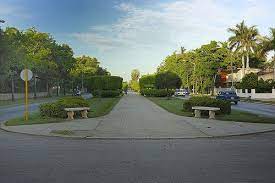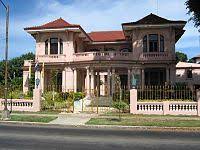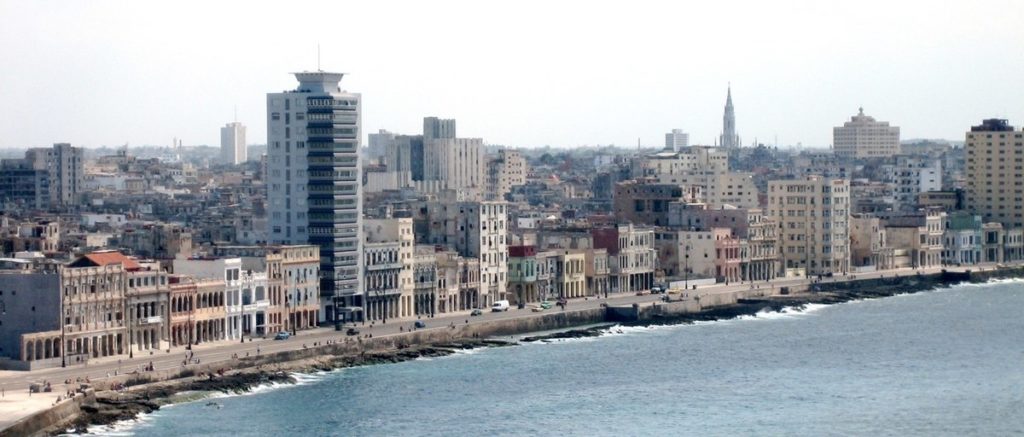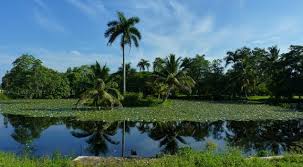La Quinta Avenida es una de las arterias principales, del municipio de Playa, en La Habana (Cuba). Localizada en el sector de Miramar, que fue conocida en un inicio como Avenida de las Américas. Lo más extraordinario de la avenida es la sucesión de sedes diplomáticas del mundo entero, lo que le ha ganado el calificativo de Avenida de las Embajadas.
La Quinta Avenida habanera se extiende desde el túnel que la conecta con la calle Calzada, del Vedado, hasta el río Santa Ana, en la localidad de Santa Fe. A partir de ahí se convierte en Carretera Panamericana y llega a Mariel. Su trazado resultó decisivo para el fomento del reparto Miramar y también del Country Club Park y del reparto Playa de Marianao, que se ubica entre Miramar y el Country.
En el diseño de la importante vía intervino el arquitecto norteamericano John F Duncan, autor del monumento al presidente Grant, en Estados Unidos, junto al arquitecto cubano Leonardo Morales, graduado en la Universidad de Columbia. Por eso se dice que Miramar, con sus manzanas rectangulares de 100 x 200 m, se parece tanto a Manhattan. Se erige, en su comienzo, la Fuente de las Américas.
Más allá se encuentra el reloj, que es símbolo del municipio Playa y que, si funcionara, dejaría escuchar un sonido similar al de las campanas del Big Ben, de Londres. A la altura de la calle 42 se halla La Copa, que da nombre a la zona, y que fue donada por Carlos Miguel de Céspedes en sus días de ministro de Obras Públicas del dictador Gerardo Machado.
Pese a su paseo central arbolado, la Quinta Avenida no es una vía homogénea; cambia por trechos según su arquitectura y la época de construcción. Quizás el tramo menos parecido al resto es el que media entre las rotondas de las calles 112 y 120. Allí, en la acera sur, frente al famoso Coney Island Park, existía un conjunto de bares, billares y centros nocturnos como Panchín, Pompilio, Rumba Palace, El Niche, Choricera, Los Tres Hermanos, Pennsylvania, La Taberna de Pedro… construidos casi todos de madera, con piso de cemento y techos de zinc y que lindaban con lo marginal, pero que eran visitados por todas las clases sociales.
ANECDOTAS DE LA QUINTA AVENIDA HABANERA…
¿Sabía usted que la casa del ex presidente Ramón Grau San Martín, “la choza” que se construyó en Quinta Avenida esquina a 14, dispone de 19 cuartos de baño, sin contar los de los garajes y la piscina, y que al menos su planta alta puede recorrerse completa, pasando de habitación en habitación, sin necesidad de tener que salir a ningún corredor o pasillo?
¿Qué en la casa de la condesa de Buenavista, en Quinta Avenida y Seis, que mereció en 1929-1930 el Premio del Concurso de Fachadas del Club Rotario, habitan ahora 23 familias, lo que la convierte en una casa de vecindad en una de las mejores y más codiciadas zonas residenciales de La Habana?
¿Qué la iglesia Jesús de Miramar, en Quinta Avenida y 80 es, en cuanto a área se refiere, el templo mayor de Cuba y el segundo en cuanto a capacidad para los fieles, superado solo por la Catedral de Santiago?
COSAS DEL PASADO…
Pennsylvania era el escenario de la vedette Tula Montenegro, que lucía una anatomía descomunal. En algunos de aquellos tugurios estaba Teherán, que había cosechado éxitos en el Cotton Club, de Broadway, junto a Duke Ellington y Cab Calloway, mientras que en Choricera, El Niche o en Los Tres Hermanos y ocasionalmente en el Rumba Palace montaba Silvano Shueg Hechevarría, el célebre Chory, “el artista que se anunciaba solo”, sus espectáculos escalofriantes con aquella música que sacaba de timbales, sartenes y botellas vacías.
Delante de esos centros nocturnos, en la propia acera, se alzaba todo un tinglado de puestos de fritas. Uno al lado del otro. Lo que hizo que la zona fuera conocida como Las Fritas de Marianao. Detrás, disimulados por los ficus, había un número impreciso de posadas y prostíbulos. Uno de ellos, muy famoso, a la altura de la calle 112, se llamaba La Finquita.
Ya nada de eso existe. Desaparecieron muchos de aquellos locales o se convirtieron en los años 90 en cafeterías de comida rápida, identificadas por una estridente pintura de rojo catchup y amarillo mostaza. Dice el arquitecto Mario Coyula: “Quizás buscando una cubanía extemporánea y forzada, o como reflejo de la ruralización creciente de la capital, el Rumba Palace ha sido tocado con una empinada cobija de guano, a manera de sombrero campesino”.
Más allá de lo anecdótico, algún día habrá que valorar cuánto deben el son y la rumba, y la rumba de cajón, a aquella escuela de músicos populares y a ese escenario imprescindible que para la música cubana fueron “Las Fritas de Marianao”, de la Quinta Avenida.

* LOS QUE OLVIDAN SU HISTORIA ESTAN CONDENADOS A REPETIRLA.
* THOSE WHO FORGET THEIR HISTORY ARE CONDEMNED TO REPEAT IT.
THE FIFTH AVENUE IN HAVANA, CUBA IS KNOWN AS THE EMBASSY ROAD. PHOTOS.
Fifth Avenue is one of the main arteries in the municipality of Playa, in Havana (Cuba). Located in the Miramar sector, which was initially known as Avenida de las Américas. The most extraordinary thing about the avenue is the succession of diplomatic headquarters from around the world, which has earned it the qualification of Avenida de las Embassies.
Havana’s Fifth Avenue extends from the tunnel that connects it with Calzada Street, in Vedado, to the Santa Ana River, in the town of Santa Fe. From there it becomes the Pan-American Highway and reaches Mariel. Its layout was decisive for the promotion of the Miramar district and also of the Country Club Park and the Playa de Marianao district, which is located between Miramar and the Country.
The American architect John F Duncan, author of the monument to President Grant, in the United States, participated in the design of the important road, together with the Cuban architect Leonardo Morales, a graduate of Columbia University. That’s why Miramar, with its 100 x 200 m rectangular blocks, is said to look so much like Manhattan. At its beginning stands the Fountain of the Americas.
Further on is the clock, which is a symbol of the Playa municipality and which, if it worked, would let out a sound similar to that of the bells of Big Ben in London. At the height of 42nd Street is La Copa, which gives its name to the area, and which was donated by Carlos Miguel de Céspedes in his days as Minister of Public Works of the dictator Gerardo Machado.
Despite its tree-lined central promenade, Fifth Avenue is not a homogeneous thoroughfare; it changes by stretch according to its architecture and the time of construction. Perhaps the least similar section to the rest is the one between the roundabouts of 112th and 120th streets. There, on the south sidewalk, in front of the famous Coney Island Park, there was a group of bars, billiards, and nightclubs such as Panchín, Pompilio, Rumba Palace, El Niche, Choricera, Los Tres Hermanos, Pennsylvania, La Taberna de Pedro… almost all built of wood, with cement floors and zinc roofs, bordering on the marginal, but visited by all social classes.
ANECDOTES FROM HAVANA’S FIFTH AVENUE…
Did you know that the house of former President Ramón Grau San Martín, “the shack” that was built on Fifth Avenue at the corner of 14, has 19 bathrooms, not counting those in the garages and the pool and that at least it upstairs can be covered completely, going from room to room, without having to go out to any corridor or corridor?
What, in the house of the Countess of Buenavista, on Fifth Avenue and Sixth, which won the Rotary Club Facade Contest Prize in 1929-1930, is now home to 23 families, which makes it a tenement house one of the best and most coveted residential areas of Havana?
That the Jesús de Miramar church, on Fifth Avenue and 80, is, in terms of area, the largest temple in Cuba and the second in terms of capacity for the faithful, surpassed only by the Cathedral of Santiago?
THINGS OF THE PAST…
Pennsylvania was the setting for the vedette Tula Montenegro, who sported enormous anatomy. In some of those slums was Tehrán, who had achieved success at the Cotton Club, on Broadway, along with Duke Ellington and Cab Calloway, while in Choricera, El Niche or in Los Tres Hermanos and occasionally in the Rumba Palace, Silvano Shueg Hechevarría performed. , the famous Chory, “the artist who announced himself”, his chilling shows with that music that he drew from kettledrums, pans, and empty bottles.
In front of those nightclubs, on the sidewalk itself, there was a whole shed of fried food stalls. Next to each other. What made the area known as Las Fritas de Marianao? Behind, hidden by the ficus, there was an imprecise number of inns and brothels. One of them, very famous, at the height of 112th Street, was called La Finquita.
None of that exists anymore. Many of those places disappeared or were converted in the 90s into fast food cafes, identified by a garish paint of red catchup and mustard yellow. Architect Mario Coyula says: “Perhaps seeking an extemporaneous and forced Cubanness, or as a reflection of the growing ruralization of the capital, the Rumba Palace has been covered with a steep guano blanket, like a peasant hat.”
Beyond the anecdotal, one day it will be necessary to assess how much the son and the rumba, and the Cajon rumba, owe to that school of popular musicians and to that essential stage that for Cuban music was “Las Fritas de Marianao”, by the Fifth Avenue.
Agencies/ Wiki/ Ciro Bianchi/ Extractos/ Excerpts/ Internet Photos/ Arnoldo Varona/ www.TheCubanHistory.com
THE CUBAN HISTORY, HOLLYWOOD.

* LOS QUE OLVIDAN SU HISTORIA ESTAN CONDENADOS A REPETIRLA.
* THOSE WHO FORGET THEIR HISTORY ARE CONDEMNED TO REPEAT IT.



 LA QUINTA Avenida de la Habana, Cuba, conocida como el de las Embajadas. PHOTOS. * THE FIFTH Avenue in Havana, Cuba is Known as the Embassy Road. PHOTOS.
LA QUINTA Avenida de la Habana, Cuba, conocida como el de las Embajadas. PHOTOS. * THE FIFTH Avenue in Havana, Cuba is Known as the Embassy Road. PHOTOS.




